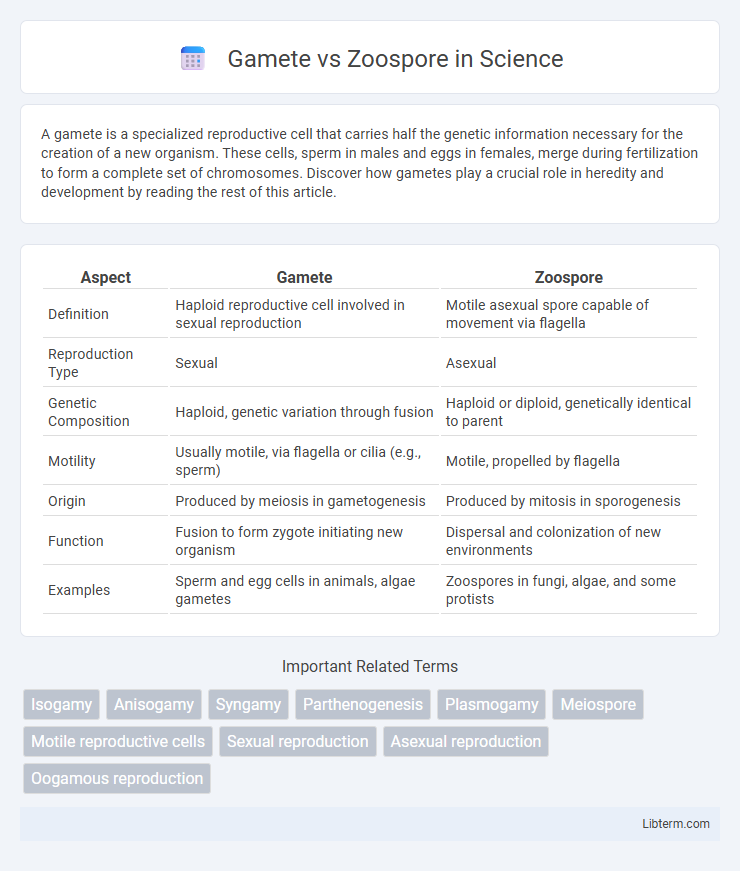A gamete is a specialized reproductive cell that carries half the genetic information necessary for the creation of a new organism. These cells, sperm in males and eggs in females, merge during fertilization to form a complete set of chromosomes. Discover how gametes play a crucial role in heredity and development by reading the rest of this article.
Table of Comparison
| Aspect | Gamete | Zoospore |
|---|---|---|
| Definition | Haploid reproductive cell involved in sexual reproduction | Motile asexual spore capable of movement via flagella |
| Reproduction Type | Sexual | Asexual |
| Genetic Composition | Haploid, genetic variation through fusion | Haploid or diploid, genetically identical to parent |
| Motility | Usually motile, via flagella or cilia (e.g., sperm) | Motile, propelled by flagella |
| Origin | Produced by meiosis in gametogenesis | Produced by mitosis in sporogenesis |
| Function | Fusion to form zygote initiating new organism | Dispersal and colonization of new environments |
| Examples | Sperm and egg cells in animals, algae gametes | Zoospores in fungi, algae, and some protists |
Introduction to Gametes and Zoospores
Gametes are specialized reproductive cells involved in sexual reproduction, containing half the genetic material of the parent organism, which fuse during fertilization to form a zygote. Zoospores are motile asexual spores equipped with flagella that enable movement in aquatic environments, facilitating dispersal and colonization without genetic recombination. Both gametes and zoospores play crucial roles in the life cycles of various plants, algae, and fungi, but differ fundamentally in their reproductive functions and genetic contributions.
Definition of Gamete
A gamete is a haploid reproductive cell that fuses with another gamete during fertilization to form a diploid zygote, playing a crucial role in sexual reproduction. Unlike zoospores, which are asexual, motile spores used for dispersal, gametes are specialized for genetic recombination and diversity. Gametes typically exhibit motility through flagella and are produced by organisms such as animals, plants, and algae.
Definition of Zoospore
A zoospore is a motile, asexual spore equipped with flagella that enables it to swim in aquatic environments, primarily found in fungi and algae. Unlike gametes, which are sexual reproductive cells involved in fertilization, zoospores are produced through mitosis and serve as a means of dispersal and propagation without genetic recombination. Their ability to move actively distinguishes zoospores from non-motile spores and highlights their ecological role in colonizing new habitats.
Key Structural Differences
Gametes are typically haploid cells involved in sexual reproduction, characterized by the presence of flagella in many species, enabling motility for fertilization. Zoospores are asexual, motile spores also equipped with flagella but differ structurally by having a more simplified cellular organization tailored for dispersal rather than fusion. Unlike gametes, zoospores often possess two unequal flagella types, one whiplash and one tinsel, which facilitate different swimming patterns essential for colonization.
Modes of Reproduction: Sexual vs Asexual
Gametes are involved in sexual reproduction, combining genetic material from two parent organisms to create genetically diverse offspring. Zoospores reproduce asexually by forming genetically identical spores that disperse and develop into new individuals without genetic recombination. The sexual reproduction via gametes increases genetic variation, whereas asexual reproduction through zoospores allows rapid population growth in stable environments.
Formation and Development Process
Gametes develop through gametogenesis involving meiosis and often require fertilization to form a zygote, initiating organismal development. Zoospores arise from mitotic division in sporangia without fertilization and are motile, enabling direct dispersal and colonization. Gamete fusion leads to genetic recombination, whereas zoospores propagate asexually, maintaining genetic consistency.
Biological Roles and Functions
Gametes serve as specialized reproductive cells that fuse during sexual reproduction to form a zygote, ensuring genetic diversity in organisms. Zoospores function as motile asexual spores, enabling rapid dispersal and colonization in aquatic and moist environments. Both play crucial biological roles in propagating species but through distinct reproductive strategies: gametes in sexual reproduction and zoospores in asexual reproduction.
Mobility and Motility Mechanisms
Gametes typically exhibit active motility mechanisms such as flagella or cilia, enabling directed movement toward fertilization sites, crucial for sexual reproduction. Zoospores possess flagella as well, often varying in number and arrangement, facilitating dispersal in aquatic environments by swimming or gliding motions. While both gametes and zoospores rely on flagellar propulsion for mobility, gamete motility is primarily geared towards navigating chemical signals for fertilization, whereas zoospore motility focuses on colonization and survival in diverse habitats.
Ecological and Evolutionary Significance
Gametes enable sexual reproduction by fusing genetic material from two parents, promoting genetic diversity which enhances adaptability in changing environments. Zoospores, as motile asexual spores, allow rapid colonization and survival in aquatic habitats, contributing to species dispersal and ecological resilience. The evolutionary significance lies in gametes fostering long-term species evolution through recombination, while zoospores ensure immediate population sustainability and environmental exploitation.
Conclusion: Gamete vs Zoospore Comparison
Gametes and zoospores serve distinct reproductive functions in different organisms, with gametes involved in sexual reproduction as haploid cells that fuse to form a zygote. Zoospores are asexual, motile spores produced by certain algae, fungi, and protists, enabling rapid dispersal without genetic recombination. Understanding these differences highlights the unique roles gametes and zoospores play in organismal life cycles and evolutionary strategies.
Gamete Infographic

 libterm.com
libterm.com